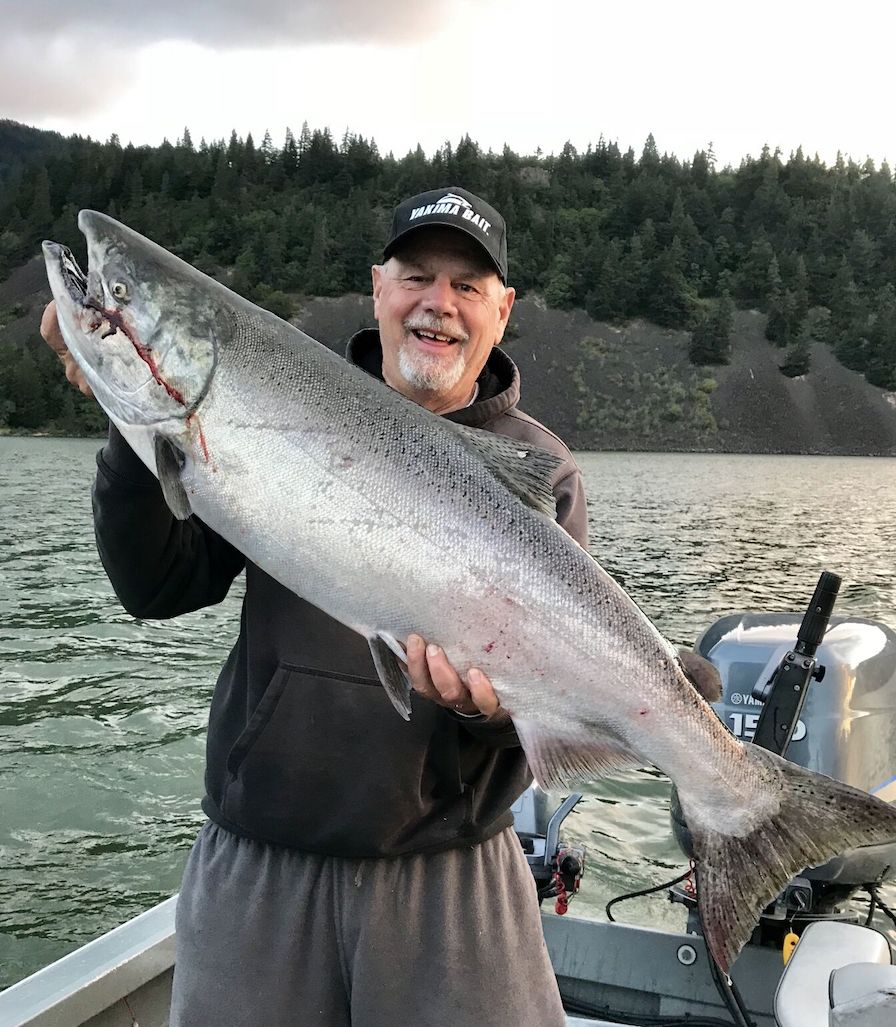forum
library
tutorial
contact

Now is the Time to Land a
Big Fall Chinook on the mid-Columbia River
by Roger Phillips
Yakima Herald-Republic, September 27, 2022
|
the film forum library tutorial contact |

|
Now is the Time to Land a
by Roger Phillips
|
The big fish, some weighing 30 pounds or more, spawn in the last free flowing stretch
of the Columbia, the waters below Priest Rapids Dam known as the Hanford Reach.
 This is the time of year many local anglers wait for all year long.
This is the time of year many local anglers wait for all year long.
It is prime time for fishing for fall chinook in the mid-Columbia.
As of Sunday, some 123,900 fall chinook salmon had climbed the fish ladders at McNary Dam near the Tri-Cities. While some of those fish will make a right-hand turn and head up the Snake when they get to Pasco, the bulk of them are just now reaching their spawning grounds near Vernita on the Columbia River.
The big fish, some weighing 30 pounds or more, spawn in the last free flowing stretch of the Columbia, the waters below Priest Rapids Dam known as the Hanford Reach.
In deeper holes from Richland, to Ringold, to White Bluffs and on up to the waters just above and below the Vernita Bridge, anglers have been fishing for the salmon since earlier this month.
Now that there are tens of thousands of fish in this portion of the Columbia, the fishing -- or more accurately, the catching -- should just get better and better.
Earlier this year fisheries officials looked into their crystal ball and predicted that some 230,000 fall chinook, also known as upriver brights, would be making it above Bonneville Dam in September and October. So far over 482,000 fall chinook have migrated over the dam, which gives anglers even more to be excited about as those fish keep working up the river.
When the fish start arriving, so do the anglers. This is the time of year when motor homes, fifth wheels, travel trailers, campers and wall tents are set up in the sagebrush flats just above the Vernita Bridge as anglers from all around the West show up for a shot at a big fall chinook salmon.
Some of the anglers arrive at this makeshift RV city in early September and stay through the season, fishing day after day, waiting for the fish to arrive.
And when the salmon arrive, the catching can be really good.
Virtually all of the salmon fishing in this portion of the Columbia is done from boats, but there are several different fishing methods, lures and baits that are used to entice the fish into biting.
Even though the salmon are not actively feeding, and haven't been since they left saltwater a couple of weeks or more ago, they will still bite herring. Cut and rigged to spin in a slow roll, the urge to strike the injured baitfish is still there, and the salmon will bite.
Some anglers will put the herring behind a Pro-Troll rotating flasher or an in-line flasher like a Fish Flash for added attraction, while others will run it straight without any kind of attractor.
More popular in recent years has been the use of lures that imitate the wounded roll of a bait fish. Several sizes and models of Super Baits have been a productive choice. And, the newer SpinFish has been another popular choice in the past couple of years.
Both lures allow bait to be added for extra scent attraction. Again, these lures are worked behind a Pro-Troll flasher or a Fish Flash for added attraction and action.
While not as popular as it once was, some anglers will still use big wiggling plugs like a Magnum Wiggle Wart, FlatFish or Kwikfish. Another option is the diving, wiggling MagLip.
The FlatFish style plugs can be "wrapped" with a piece of herring or sardine on the belly of the lure, adding scent to the wiggle and rattle of the larger plugs, which can entice strikes from the aggravated fish.
All of these lures need assistance to get to the depths where the salmon are holding and most anglers now use a heavy lead dropper weight on the main line about 18 inches ahead of the flasher to get the lures down near the bottom.
Another option to get the bait or lures down into fish-holding water is to use a downrigger.
Later in the season some anglers will use cured salmon eggs as their bait of choice and will bounce them along the bottom of the river. This is a particularly good method for the smaller jack salmon, but the big fish will hit eggs too.
Anglers are still catching fall salmon lower in the Columbia, at Drano Lake, and at the mouth of the Klickitat and Deschutes Rivers, but as the chinook keep heading upstream the best fishing will be near the Tri-Cities and into the waters near Vernita.
The kings are coming to the Hanford Reach, and every day more and more fish are showing up. Tens of thousands are there now, and many more are due in the days ahead.
With the season open only until Oct. 15, the next two weeks will offer prime fishing. Now's the time to get out there and do some catching.
learn more on topics covered in the film
see the video
read the script
learn the songs
discussion forum
